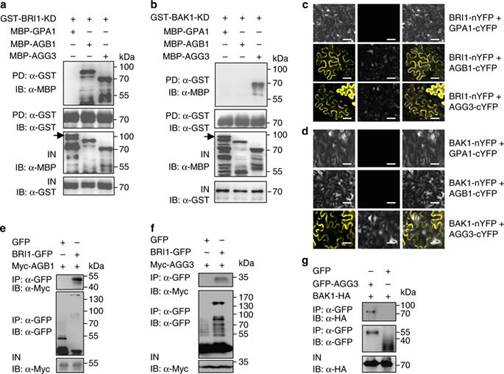李云海研究组等发现糖信号调控植物生长发育的新机制
来源:《自然通讯》
作者:李云海等
时间:2018-04-25

在植物、动物和细菌中,糖类不仅能作为体内能源和碳骨架的提供者,还作为非常重要的信号分子调控植物的生长发育过程。虽然近年来在动物和酵母中糖揭示了几个糖信号途径,但植物不同于动物和细菌,植物是通过光合作用产生糖类的自营生物,植物体可能通过其它的分子机制来感受糖信号的变化从而调控植物的生长发育。
中国科学院遗传与发育生物学研究所李云海研究组与安徽农业大学程备久教授,中科院植物所郑雷英副研究员和中科院遗传与发育生物学研究所汪迎春研究员合作,揭示了油菜素内酯受体 BRI1 和 BAK1 介导的糖信号转导的新机制。研究结果表明 BRI1 和 BAK1 的功能缺失突变体表现出对糖反应不敏感的表型,BRI1 和 BAK1 之间的蛋白互作和磷酸化水平受到糖浓度调控,而且 BRI1 和 BAK1 蛋白在细胞膜上的定位也受糖浓度所调控。进一步研究发现,BRI1 和 BAK1 与 G 蛋白作用在同一遗传途径中参与糖信号的调控。相关的生化分析表明 BRI1 和 BAK1 不仅能够与 G 蛋白亚基在体内和体外互作,而且还在体内和体外磷酸化 G 蛋白亚基。 BRI1 和 BAK1 对 G 蛋白的磷酸化影响了 GPA1 和 AGB1/AGGs 的解离,从而调控了植物生长发育。
这一研究结果于 2018 年 4 月 18 日在线发表于 Nature Communications 杂志(DOI:10.1038/s41467-018-03884-8)。李云海研究组的已毕业博士研究生彭元成,陈亮亮和李胜军为该论文的共同第一作者。该研究得到了国家自然科学基金和中科院先导专项 B 的资助。 (来源:中国科学院遗传与发育生物学研究所)
BRI1 and BAK1 interact with G proteins and regulate sugar-responsive growth and development in Arabidopsis
Abstract Sugars function as signal molecules to regulate growth, development, and gene expression in plants, yeasts, and animals. A coordination of sugar availability with phytohormone signals is crucial for plant growth and development. The molecular link between sugar availability and hormone-dependent plant growth are largely unknown. Here we report that BRI1 and BAK1 are involved in sugar-responsive growth and development. Glucose influences the physical interactions and phosphorylations of BRI1 and BAK1 in a concentration-dependent manner. BRI1 and BAK1 physically interact with G proteins that are essential for mediating sugar signaling. Biochemical data show that BRI1 can phosphorylate G protein β subunit and γ subunits, and BAK1 can phosphorylate G protein γ subunits. Genetic analyses suggest that BRI1 and BAK1 function in a common pathway with G-protein subunits to regulate sugar responses. Thus, our findings reveal an important genetic and molecular mechanism by which BR receptors associate with G proteins to regulate sugar-responsive growth and development.
原文链接:https://www.nature.com/articles/s41467-018-03884-8




